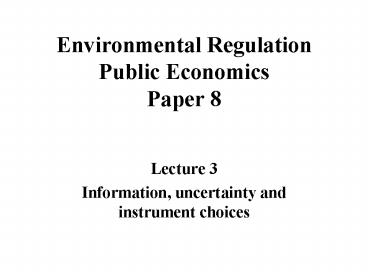Environmental Regulation Public Economics Paper 8 - PowerPoint PPT Presentation
1 / 30
Title:
Environmental Regulation Public Economics Paper 8
Description:
Marginal abatement. cost should be. the same in all firms. The shadow ... Marginal. abatement. cost, firm 1. Emission taxes. The regulator levies a (uniform) ... – PowerPoint PPT presentation
Number of Views:34
Avg rating:3.0/5.0
Title: Environmental Regulation Public Economics Paper 8
1
Environmental RegulationPublic EconomicsPaper 8
- Lecture 3
- Information, uncertainty and instrument choices
2
Motivation
Optimal environmental regulation
requires information on
- Preferences (environmental damage)
- Abatement technology
- quantifiable uncertainty
- no information about damage.
3
Outline
- Uncertainty and instrument choice
- The least cost principle
- emission taxes
- tradable permits
- performance standards
- Instrument choice
4
Uncertainty and instrument choice
The equivalence result under certainty
P tradable permit system
T Pigiouvian tax
with
5
(No Transcript)
6
Uncertainty
- Preference uncertainty gt
random
- Technology uncertainty gt
Firms decide emission levels
0
1
time
Target is set
Instrument is chosen
Uncertainty resolved
7
Ex ante optimal target
Uncertainty implies that the ex ante optimal
target is different from the ex post optimal one,
but
only uncertainty related to technology has
implications for the instrument choice!
(with some qualifications)
8
Uncertainty about preferences.
C
B
A
9
Social damage uncertainty(preferences)
- The deadweight loss due to uncertainty is the
same for both instruments because - polluters reaction to both T and P is
determined by technology (marginal benefit of
emission). - Information on social marginal damage is only
relevant for the determination of the target, not
for how it is implemented.
10
Uncertainty about technology
P
B
T
A
11
Uncertainty about technology
Underestimate the benefit of emission gt
- T result in too much emission.
- P result in too little emission.
Marginal benefit
Level of emission
P
unknown
known
unknown
T
known
12
The choice between P and T
Social loss under P
P
Social loss under T
B
T
A
13
The choice between P and T
Social loss under P
P
TB
A
14
The choice between P and T
PB
Social loss under T
T
A
15
Optimal instrument choices
- Preference uncertainty makes no difference
- Technology uncertainty
- P if SMD steep great concern about damage
- T is SMD flat great concern about costs
- Robustness
- P vs. T
- Optimal policy is a convex combination
non-linear tax gt both types of uncertainty
matter.
16
The standard and charge approach
Not directly related to damage
Acceptable standard
How can this standard be implemented at least
cost when abatement technologies are unknown to
the regulator?
17
The model
Ci
Abatement cost
Abatement
ai
Emission
Emission in absence of abatement
18
The least cost solution
The shadow price of emission
standard
s.t
Marginal abatement cost should be the same in all
firms.
Solution
19
Marginal abatement cost, firm 1.
Marginal abatement cost, firm 2.
20
Emission taxes
The regulator levies a (uniform) emission tax on
each firm.
Only if
Solution
21
- Without knowledge of the shadow price of
emission, the regulator cannot set the right tax
ex ante - gt iterative process of trail and error.
A uniform emission tax can implement a given
standard at the least cost but it may require a
period of adjustment to reach the standard.
22
Single zone emission permit system (EPS)
- A permit is the right to emit one unit of waste.
- Trading can take place on one-to-one basis.
- permits are grandfathered to firm i.
- Pp is the equilibrium price at the resulting
competitive market for emission permits.
Standard is achieved!
23
Marginal costs are equalized
Solution
An EPS can implement the standard at least cost
without the need for an adjustment period.
24
The least cost theorem
- A system of tradable permits can (if the market
is competitive and transaction costs are low)
implement a given environmental target at the
least (abatement) cost. - This efficiency outcome is independent of the
initial allocation of the permits. - Strict separation of efficiency and equity
considerations.
25
Performance standard
Uniform standard
Standard achieved
But at what cost?
26
Marginal abatement cost, firm 1.
B
C
D
Marginal abatement cost, firm 2.
A
E
O
27
Performance standards
- Cannot implement the least cost solution.
- Do not provide any dynamic incentives for
emission reduction (as opposite to taxes and
tradable permits).
28
Criterion
Emission tax
EPS
Iterative process
Automatically satisfied
Standard
Adjustment needed
No adjustment needed
Growth/shocks
Polluters to the public
Initial allocation
Equity
Double dividend?
No double dividend
Revenue
Non-uniform taxes
Ambient permit system
Spatial aspects
29
Summary
- Uncertainty about technologies affects the
optimal choice between permits and taxes. - Market-based instruments can be used to implement
an acceptable environmental standard at the least
cost.
30
What is next?
- Green tax reforms and the double dividend.































